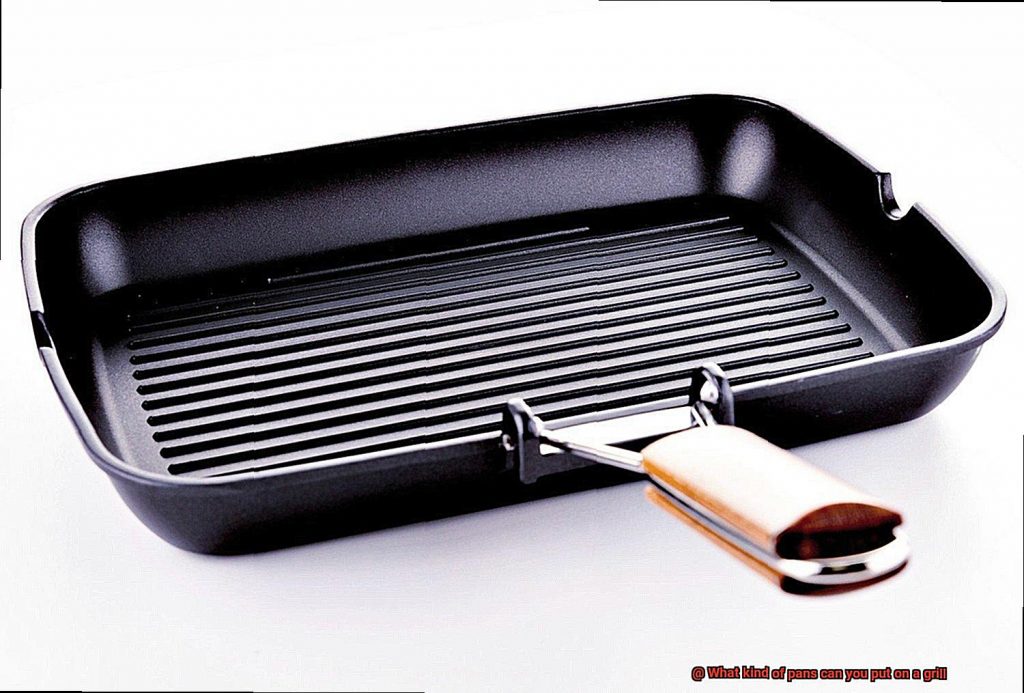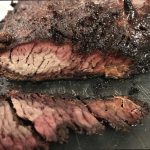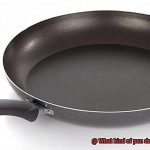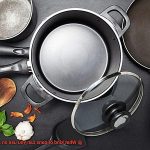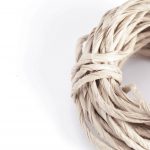Picture this: it’s a scorching summer day, and the tantalizing aroma of barbecue is wafting through the air. You’re excited to cook up a storm on your grill, but sometimes you want to switch things up and use a pan instead. That begs the question: what kind of pans can you put on a grill? Don’t fret; we’ve got you covered.
Cooking with pans on a grill is not only practical but also versatile. You can whip up side dishes, sauté veggies or even make pancakes. But before you go ahead and place any old pan on your grill, know that not all are created equal. Some can handle high temperatures without warping or melting, while others can’t take the heat.
In this blog post, we’ll explore the different types of pans that are safe for grilling. From cast iron to stainless steel to non-stick options, we’ll cover it all. We’ll also give you the lowdown on which pans work best for grilling steaks, chicken, fish, and veggies – so get ready to impress your guests with your newfound knowledge.
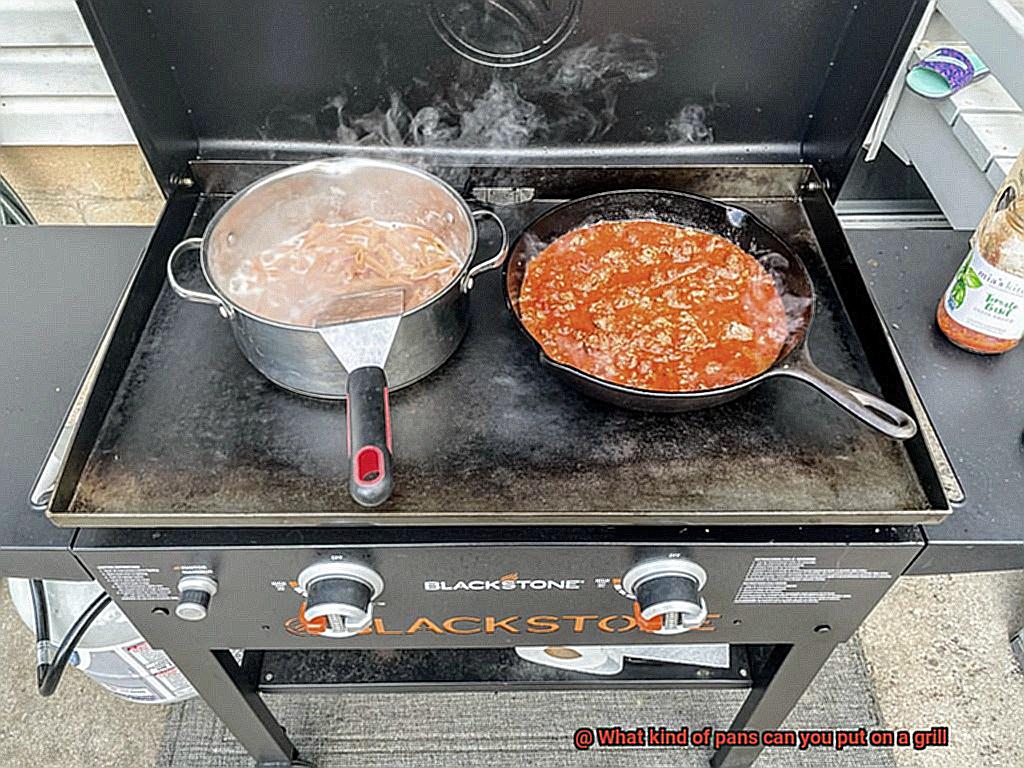
But wait, there’s more. We’ll also share some common pitfalls to avoid when cooking with pans on a grill – because no one wants their food sticking or burning.
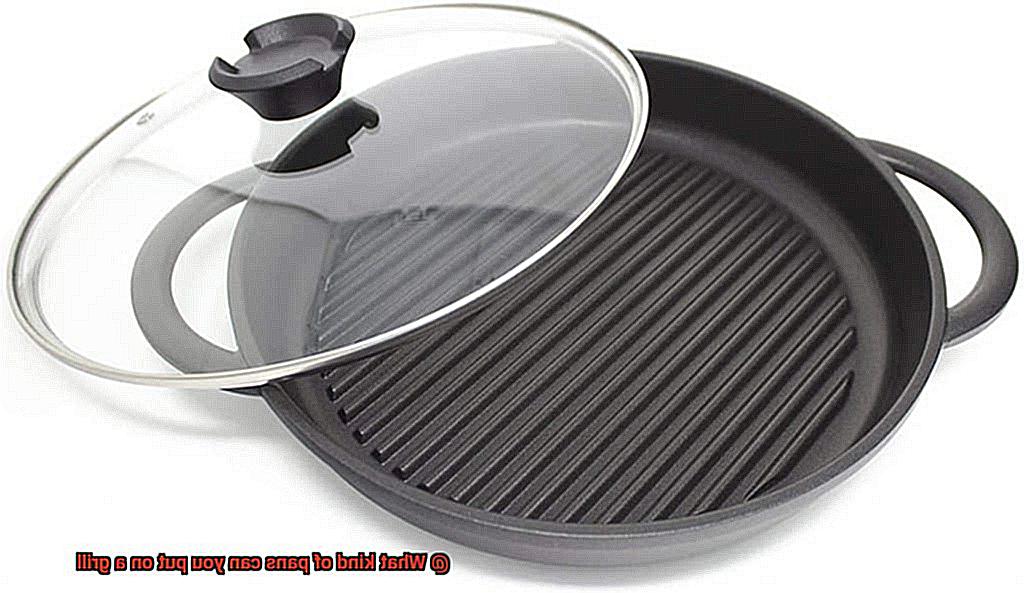
So if you’re ready to elevate your barbecue game with some pan-cooking action, keep reading. Trust us; you won’t want to miss out on these tips and tricks.
Contents
What Material Should I Choose for My Grill Pan?
Choosing the right material for your grill pan can make all the difference in your outdoor cooking experience. With so many options available, it’s important to consider what you’ll be cooking and how much maintenance you’re willing to do.
One classic choice for grill pans is cast iron. Renowned for its durability and ability to retain heat, cast iron is perfect for searing meats and creating beautiful grill marks. However, it can be heavy and requires a bit of maintenance to keep it in good condition.
If you’re looking for something low-maintenance, stainless steel is a great option. Lightweight and easy to clean, stainless steel is ideal for those who want a fuss-free option. However, it doesn’t retain heat as well as cast iron, so it may not create the same grill marks.
For delicate foods like fish and vegetables, aluminum is a great choice. This lightweight material heats up quickly, but be cautious when using acidic ingredients as they can react with aluminum.
Ceramic grill pans are another great option. With their non-stick surface, ceramic pans allow for easy cleanup and prevent food from sticking. They also retain heat well, making them perfect for searing meat. However, they can be more fragile than other materials and may break or chip if dropped.
Pros and Cons of Cast Iron Pans
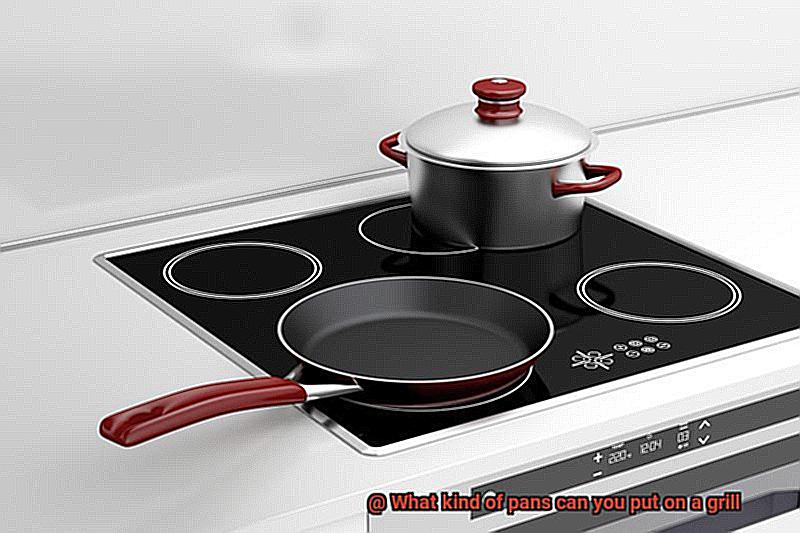
First, let’s dive into the pros. Cast iron pans are a popular choice for grilling enthusiasts due to their durability and heat retention capabilities. Their heavy-duty cast iron construction allows them to withstand high temperatures without warping or cracking, while also evenly distributing heat throughout the pan. But that’s not all – their versatility means they can be used on a stove, in an oven, and even over a campfire, making them an ideal choice for outdoor cooking enthusiasts who want to cook a variety of dishes using a single pan.
One of the most significant advantages of cast iron pans is their ability to create a natural non-stick surface over time. When properly seasoned, the pan develops a layer of polymerized oil that prevents food from sticking to the surface. Unlike chemical-based non-stick sprays or coatings that can be harmful to your health, this natural non-stick coating eliminates the need for any additional additives.
However, there are also some drawbacks to using cast iron pans on the grill. The first and most noticeable is their weight. Cast iron pans are much heavier than other types of grilling pans, which can make them difficult to maneuver on the grill. Additionally, they take longer to heat up than other materials such as stainless steel or aluminum.
Another potential downside of using cast iron pans is their maintenance requirements. While seasoning may be easy, it does require regular maintenance to keep the non-stick surface intact and prevent rusting. Failure to season the pan regularly can lead to food sticking and rusting.
Despite these drawbacks, cast iron pans remain an excellent choice for grilling enthusiasts who value durability, versatility, and even heat distribution. With proper care and maintenance, a cast iron pan can last for generations and become a beloved family heirloom.
Pros and Cons of Stainless Steel Pans
You’re missing out on some of the benefits that this durable and non-reactive material has to offer. However, like with any cooking tool, there are pros and cons to using stainless steel pans on the grill.
Let’s start with the positives: stainless steel pans are incredibly durable and perfect for outdoor cooking. They can withstand scratches, dents, and other types of damage that can occur during grilling. Plus, they’re excellent at retaining heat, which is crucial for achieving that perfect sear on your meats and veggies.
Another major advantage of stainless steel pans is their non-reactive surface. This means that they won’t interact with acidic foods like tomatoes or citrus fruits, which can cause a metallic taste or discoloration in your food. They’re also incredibly easy to clean and maintain. Just a few quick wipes with a damp cloth and you’re good to go.
However, there are also some downsides to using stainless steel pans on the grill. One of the main drawbacks is their uneven heat distribution. Hot spots can occur on the pan, causing your food to cook unevenly or even burn in certain areas. This can be easily avoided by pre-heating the pan and adjusting the temperature as necessary.
Another challenge to watch out for is sticking. If your pan isn’t properly seasoned or the grill isn’t hot enough, food can easily become stuck to the surface of the pan. To prevent this from happening, make sure to season your pan before use and ensure that your grill is heated to the appropriate temperature before cooking.
Non-Stick Pans: To Use or Not to Use?
When it comes to grilling, having the right equipment is essential. But can you trust your beloved non-stick pans to handle the heat of a grill? As an expert on this topic, I have to advise you against it.
Firstly, not all non-stick coatings are created equal. Some are made with materials that simply can’t handle high temperatures, rendering them unsuitable for grilling. And if you’re worried about chemicals leaching into your food, using a non-stick pan on a grill could be a recipe for disaster.
But that’s not all. The intense heat of a grill can cause non-stick coatings to break down and release harmful chemicals into your food. And if that’s not enough of a deterrent, using non-stick pans on a grill also puts you at risk of warping or melting your pan, resulting in a messy and potentially dangerous situation.
So what are your options? Cast iron or stainless steel pans are ideal for grilling. They’re designed to withstand high temperatures without warping or melting, making them a reliable choice for any grilling enthusiast. Additionally, these pans offer even heat distribution and won’t react with acidic foods, making them the perfect complement to your outdoor cooking setup.
Shape and Size Considerations for Grill Pans
When it comes to grill pans, there are several shape and size considerations that you need to keep in mind.
Firstly, the shape of your grill pan should complement the shape of your grill for even cooking and safety purposes. If you have a round grill, then a circular or oval-shaped pan will fit best, while a rectangular or square-shaped pan is more suitable for a rectangular grill. It’s essential to choose a pan that fits well on your grill without hanging over the edges, which can cause uneven cooking and potential safety hazards.
Secondly, the size of your grill pan plays a crucial role in determining how well your food will cook. A smaller pan is ideal for cooking smaller portions or delicate foods that require more attention. In contrast, a larger pan is better suited for cooking bigger cuts of meat or larger quantities of vegetables. However, keep in mind that a larger pan may take longer to heat up and may require more fuel to maintain the desired temperature.
Finally, the depth of your grill pan should be taken into consideration when selecting a pan for your dish. A deep pan is excellent for cooking dishes with sauces or marinades as it can prevent them from spilling over onto the grill. On the other hand, a shallow pan is perfect for grilling vegetables or seafood as it allows for even cooking and prevents them from getting too soggy.
Adjusting Cooking Times with a Grill Pan
Grilling with a pan can be an excellent way to enjoy juicy, flavorful meats and vegetables. However, it’s important to adjust your cooking times carefully to avoid undercooked or overcooked food. Understanding the basics of adjusting cooking times with a grill pan will help you create mouth-watering meals every time.
The type of pan you use is a crucial factor in adjusting cooking times. Cast iron grill pans retain heat better than stainless steel ones, which means that cooking times will differ. Pay close attention to your food while grilling as the intense heat from the pan can cause the outside to cook faster than the inside.
Thicker cuts of meat such as steak or pork chops require extra attention, as they can be challenging to cook evenly. Using a meat thermometer to check the internal temperature will help ensure that your food is cooked to perfection.
The type of food also plays an essential role in adjusting cooking times. Vegetables and seafood typically cook faster than meat, so plan accordingly. For instance, if you’re grilling shrimp and vegetables on a skewer, the shrimp may need only a few minutes to cook while the vegetables require more time.
Different grills have varying heat outputs, so it’s essential to adjust your cooking times accordingly. Gas grills typically have higher heat outputs compared to charcoal grills. When using a grill pan on an indoor stove, be mindful of the type of stove and adjust the heat settings as needed.
Monitoring Temperature when Using a Grill Pan
Grill pans are a great way to cook up a delicious meal, but getting the perfect finish can be challenging. One of the most crucial factors to pay attention to when cooking with a grill pan is the temperature. Whether it’s too hot or too cold, the temperature of the pan can significantly impact your food’s final outcome, leading to undercooked or overcooked meals. Fear not, though; there are a few simple methods you can use to monitor the temperature effectively and achieve perfectly cooked food.
Using an infrared thermometer is one of the best ways to measure your grill pan’s surface temperature quickly and accurately. This type of thermometer is straightforward to use; all you have to do is point it at your pan, and it will give you an instant reading. This method helps you ensure that your pan is hot enough before you start cooking and prevent any potential disaster.
Another useful tool is a probe thermometer with a long, thin probe that can be inserted into the food to measure its internal temperature. By monitoring the internal temperature of your food, you can ensure that it’s cooked all the way through, especially for meats like chicken and pork, which need to reach an internal temperature of 165°F to be safe for consumption.
In addition to using thermometers, you can also monitor the temperature by paying attention to visual cues. For instance, if you’re grilling steak and it starts turning brown on the outside but remains pink on the inside, it’s an indication that the pan may be too hot. On the other hand, if your food takes longer than expected to cook and doesn’t brown properly, it may be a sign that the pan isn’t hot enough.
XePesz19Uvg” >
Also Read: Can You Use Pyrex on Traeger Grill?
Conclusion
Grilling is a beloved summer tradition, but sometimes we crave something different. Enter the grill pan – a versatile tool that allows you to cook everything from veggies to meats with ease. However, not all pans are created equal when it comes to grilling. High temperatures can cause warping or melting in some materials, making them unsuitable for use over an open flame.
That’s where our comprehensive guide comes in. We’ve explored the pros and cons of cast iron, stainless steel, aluminum, and ceramic grill pans. We’ve also shared tips on selecting the right size and shape for even cooking and safety.
But choosing the right pan is only half the battle. Proper cooking techniques are key to achieving perfectly cooked food every time. Adjusting cooking times and monitoring temperature with an infrared or probe thermometer will ensure your meals come out just right.
While non-stick pans may seem like a convenient option, they’re not recommended for grilling due to their inability to handle high temperatures and potential release of harmful chemicals into your food.

